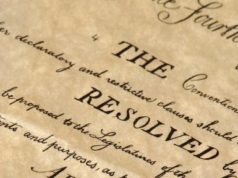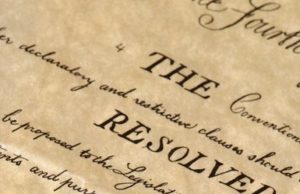Table of Contents
- 1
- 2
- 3
- 4
- 5
- 6 What is the Ratification of the Constitution?
- 7 How Long Did the Ratification of the Constitution Take?
- 8 Articles of Confederation and the ratification of the Constitution
- 9 Constitutional Articles with Regard to the Ratification of the Constitution
- 10 Which States Participated in the Ratification of the Constitution?
- 11 The First 9 States
- 12 Subsequent Ratification of the Constitution
- 13 Difficulties Experienced With Regard to the Ratification of the Constitution
- 14 The Virginia Plan
- 15 The New Jersey Plan:
- 16 The Connecticut Plan:

The ratification of the United States Constitution was a pivotal moment in American history and remains a defining moment in the country’s development. The Constitution was written at the Constitutional Convention in 1787 in Philadelphia, and it replaced the Articles of Confederation, which had proven to be too weak to govern the new nation effectively.
The process of ratification was lengthy and contentious, with debates ranging from the powers of the federal government to the rights of individual states. The Federalists, who supported the Constitution, argued that a strong central government was needed to ensure unity and stability, while the Anti-Federalists believed that such a government would be too powerful and would infringe on individual rights.
To win over the Anti-Federalists, the Federalists agreed to add a Bill of Rights to the Constitution, which guaranteed individual liberties such as freedom of speech and religion. This compromise helped secure the support of key states, and ultimately, the Constitution was ratified in 1788.
However, not all states were immediately on board. Rhode Island, the smallest state at the time, held out until 1790 before ratifying the Constitution. It is said that George Washington personally wrote a letter to the state’s leaders urging them to join the Union.
One interesting bit of trivia about the ratification of the Constitution is that the document itself was not signed until several months after it was ratified. On September 17, 1787, the Constitution was adopted by the Constitutional Convention, but it was not until December 7 of that year that Delaware became the first state to ratify it. The last state to ratify the Constitution was Rhode Island, over two years later.
Today, the Constitution remains the supreme law of the land and a symbol of American unity and democracy. Ratified over two centuries ago, it continues to shape everyday life in the United States and has inspired countless people around the world who believe in the principles of liberty, justice, and equality.
What is the Ratification of the Constitution?
The Ratification of the Constitution took place on June 21st, 1788. The Philadelphia Convention of 1787, which is also known as the Constitutional Convention, began on May 5th, 1787; this convention consisted of the finalization of the drafting process of the Constitution of the United States – the Constitution was finalized on September 17th, 1787.
How Long Did the Ratification of the Constitution Take?
The process concerning the Ratification of the Constitution was ambiguous in applicable procedure; due to the statutes expressed within the Articles of Confederation – the existing legislative document prior to the Ratification of the Constitution – a clash existing between preexisting legislation and legislation latent within the Constitution of the United States added difficulty to the subsequent ratification process:
Articles of Confederation and the ratification of the Constitution
The statutes regarding ratification expressed within Articles of Confederation mandated that legislation could only be ratified as a result of the collective approval of the entirety of the 13 United States:
The perceived inadequacies within the initial precepts of Articles of Confederation were contributory to the effort to replace it with the Constitution; this measure was enacted by the Founding Fathers – the fathers of the Constitution were concerned that a single state could overturn an otherwise-communal consent
Constitutional Articles with Regard to the Ratification of the Constitution
In contrast to the ratification process expressed within Articles of Confederation, the process conveyed within the Constitution of the United States with regard to a ratification process expressed that the approval of no less than 9 states – out of the total 12 – would be required for the ratification of Amendments:
Despite the Articles of Confederation, the new – Constitutional – process addressing the procedure in conjunction with the Ratification of the Constitution replaced the preexisting ratification protocol
The Ratification of the Constitution took place on June 21st, 1788 subsequent to the approval of 9 out of the 12 States
Which States Participated in the Ratification of the Constitution?
Although 9 States initially participated in the Ratification of the Constitution on an individual basis, each of the original 12 States subsequently ratified the Constitution:
The First 9 States
1. Delaware
2. Pennsylvania
3. New Jersey
4. Georgia
5. Connecticut
6. Massachusetts
7. Maryland
8. South Carolina
9. New Hampshire
Subsequent Ratification of the Constitution
10. Virginia
11. New York
12. North Carolina
13. Rhode Island – Rhode Island rejected the Constitution of the United States until May 29th, 1790
Difficulties Experienced With Regard to the Ratification of the Constitution
A major contingency of the ratification of the Constitution of the United States on the part of each individual state was their collective acceptance of a viable process of the selection of legislative representation; the protocol for representation expressed within the Articles of Confederation was viewed as flawed due to its uniformity with regard to every State – every state was granted equal apportionment regardless of size or population. The following proposals were set forth prior to the approval of the Connecticut Plan and subsequent ratification of the Constitution:
The Virginia Plan
The Virginia Plan was based on a bicameral legislative model-based inspired by a form of republicanism. The Virginia Plan proposed that Congress be comprised of 2 legislative entities, the lower and upper houses
The Lower Houses would be elected commensurate to each states’ population, and The Upper House would be elected by The Lower House
The New Jersey Plan:
The New Jersey Plan illustrated unicameral legislation consisting of a single Congressional legislative body in which each state would have an equal number of representatives
The Connecticut Plan:
The Connecticut Compromise introduced a legislative body that consisted of the House of Representatives and a Senate; State Representatives elected to go to the House of Representatives was commensurate on the population of the respective state
The number of senators – those individuals selected by each state to serve as representatives in the Senate – was uniform; every state, regardless of size was allowed two.





















